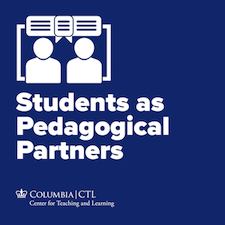What Makes a Class Inclusive?: Six Learners’ Perspectives

In Spring 2022, we asked our six undergraduate student consultants (part of the Students as Pedagogical Partners initiative) to reflect on their experiences with inclusive teaching and learning in Columbia classrooms as they transitioned back to in-person learning.
The following presents our students’ perspectives and suggestions for fostering an inclusive learning environment for students. To learn more about inclusive teaching and learning, see the CTL’s Inclusive Teaching Resources suite.
 Fostering trust and removing barriers to learning: “Physical presence in a classroom doesn’t always create a culture of trust. It requires both students and teachers working together to determine the academic needs of the student and find solutions that consider the individuality of each student.” – Victor Jandres Rivera, Columbia College
Fostering trust and removing barriers to learning: “Physical presence in a classroom doesn’t always create a culture of trust. It requires both students and teachers working together to determine the academic needs of the student and find solutions that consider the individuality of each student.” – Victor Jandres Rivera, Columbia College
 Explicit communication as an inclusive move: “I felt empowered in my learning because the expectations in terms of assignments – the final essay – and the available resources – office hours – were explicitly explained, and not assumed to be part of an ‘underlying knowledge’ of how a University works.” – Emma Fromont, General Studies
Explicit communication as an inclusive move: “I felt empowered in my learning because the expectations in terms of assignments – the final essay – and the available resources – office hours – were explicitly explained, and not assumed to be part of an ‘underlying knowledge’ of how a University works.” – Emma Fromont, General Studies

Allowing room for mistakes and open communication about the challenges of the course: “When instructors communicate about the rigor of the course, explain how to best navigate it, and make room for mistakes, I feel encouraged to learn.” – Keylin Escobar, Columbia College
 Relationship building in large courses: “TAs can make large classes feel more approachable when they serve as a fixed point of contact for a smaller group of students who meet regularly to discuss course material and clarify confusion, beyond just answering student questions.” – Ambrose Zhu, General Studies
Relationship building in large courses: “TAs can make large classes feel more approachable when they serve as a fixed point of contact for a smaller group of students who meet regularly to discuss course material and clarify confusion, beyond just answering student questions.” – Ambrose Zhu, General Studies
 A space for collaboration in which all students are included: “Collaboration is key to my learning because it encourages me to develop ownership of my own learning and a sense of belonging in my class.” – Sarah Considine, School of Engineering and Applied Science
A space for collaboration in which all students are included: “Collaboration is key to my learning because it encourages me to develop ownership of my own learning and a sense of belonging in my class.” – Sarah Considine, School of Engineering and Applied Science
 Incorporating student feedback to create an equitable learning environment: “When my professor Incorporates student feedback into the decision-making process of course design, it creates an equitable learning environment and motivates me to engage more actively in class.” – Annabelle Tang, School of Engineering and Applied Science
Incorporating student feedback to create an equitable learning environment: “When my professor Incorporates student feedback into the decision-making process of course design, it creates an equitable learning environment and motivates me to engage more actively in class.” – Annabelle Tang, School of Engineering and Applied Science
Fostering trust and removing barriers to learning.
Victor Jandres Rivera, Columbia College
 Navigating online school made me realize how much I had taken classroom culture for granted. Zoom created barriers to forming authentic connections with other students and teachers, but some of the factors preventing genuine connections didn’t disappear once we transitioned to in-person. Physical presence in a classroom doesn’t always create a culture of trust. It requires both students and teachers working together to determine the academic needs of the student and find solutions that consider the individuality of each student. Juggling health issues, family problems, jobs, and schoolwork last semester made it difficult for me to learn. I was overwhelmed, stressed out, and I struggled to manage everything. I found it intimidating to ask my professors for extensions on assignments as the expectations were that I should be resourceful and complete all my schoolwork as assigned on the syllabus. Grappling with mental illness as a college student is difficult because university settings are notoriously stressful environments, which can exacerbate my pre-existing conditions. There is a school culture telling us that taking academic responsibility is synonymous with self-reliance in the face of hardship. It wasn’t until I reached out and met with a professor outside of class that I felt acknowledged and comfortable seeking help. She was not judgemental when she heard me talk about the obstacles preventing me from completing school work and then offered for us to collaboratively find a solution that kept me on track. We all come from and currently experience different social conditions from each other. Understanding those differences creates an opportunity to acknowledge and address the inequalities within the classroom that disorient students’ sense of belonging.
Navigating online school made me realize how much I had taken classroom culture for granted. Zoom created barriers to forming authentic connections with other students and teachers, but some of the factors preventing genuine connections didn’t disappear once we transitioned to in-person. Physical presence in a classroom doesn’t always create a culture of trust. It requires both students and teachers working together to determine the academic needs of the student and find solutions that consider the individuality of each student. Juggling health issues, family problems, jobs, and schoolwork last semester made it difficult for me to learn. I was overwhelmed, stressed out, and I struggled to manage everything. I found it intimidating to ask my professors for extensions on assignments as the expectations were that I should be resourceful and complete all my schoolwork as assigned on the syllabus. Grappling with mental illness as a college student is difficult because university settings are notoriously stressful environments, which can exacerbate my pre-existing conditions. There is a school culture telling us that taking academic responsibility is synonymous with self-reliance in the face of hardship. It wasn’t until I reached out and met with a professor outside of class that I felt acknowledged and comfortable seeking help. She was not judgemental when she heard me talk about the obstacles preventing me from completing school work and then offered for us to collaboratively find a solution that kept me on track. We all come from and currently experience different social conditions from each other. Understanding those differences creates an opportunity to acknowledge and address the inequalities within the classroom that disorient students’ sense of belonging.
Explicit communication as an inclusive move.
Emma Fromont, General Studies
Feeling acknowledged as an international student with a different pedagogical background helped me learn in my classes.
I arrived at Columbia after two years of studying in France, both at Sciences Po and at the University of Aix-Marseille through distance learning. I had never heard of office hours until enrolling at Columbia. I benefited when my professors were explicit about this pedagogical practice, instead of assuming everyone in the class knew this was a valuable resource for students. In one of my online classes last Spring, despite the large size of the lecture, the professor insisted that he would like all of us to engage in office hours if we wanted to.
This availability was reinforced by a focus on students driving their learning. The final essay was prompted very early in the semester and gave us a lot of freedom to research and write about what we were most interested in. We were encouraged to present drafts and seek feedback. I probably would not have scheduled an office hour without the professor’s invitation to do so. I was able to discuss my final essay topic and it motivated me a lot. I felt empowered in my learning because the expectations in terms of assignments – the final essay – and the available resources – office hours – were explicitly explained, and not assumed to be part of an “underlying knowledge” of how a University works.
Allowing room for mistakes and open communication about the challenges of the course.
Keylin Escobar, Columbia College
 When instructors communicate about the rigor of the course, explain how to best navigate it, and make room for mistakes, I feel encouraged to learn. I don’t feel like I have to prioritize a grade above learning, and that space to make mistakes takes away the anxiety I feel to get everything right on my first try. Besides, knowing that a course is rigorous helps me realize that learning will be tough, but any struggles I have are not due to personal shortcomings.
When instructors communicate about the rigor of the course, explain how to best navigate it, and make room for mistakes, I feel encouraged to learn. I don’t feel like I have to prioritize a grade above learning, and that space to make mistakes takes away the anxiety I feel to get everything right on my first try. Besides, knowing that a course is rigorous helps me realize that learning will be tough, but any struggles I have are not due to personal shortcomings.
My Arabic professor’s openness about his own struggle with learning English as a foreign language and the frequent reminders of my own growth motivated me to keep learning. The encouraging and supportive environment fostered in that classroom let me know that if I had any difficulties in the course, I could always talk to him and that he would listen. I also can’t express how much I appreciated my professor’s acknowledgment of his own mistakes. Whether it’s that he forgot to post the homework assignment or decided that he needs to find a different way to present the content, his communication regarding these mistakes let me know that he would take accountability for said mistakes which supported my learning because I knew that I would be listened to when I expressed any concerns.
Open communication encourages a dynamic and inclusive environment for learning. My needs change throughout the course of a semester and are influenced by countless factors, so knowing that I can freely communicate those needs and make mistakes along the way is invaluable. Without such an environment, a class is reduced to a grade, and a grade is meaningless to me outside the context of that course. Inclusivity fostered through open and honest communication assures me that my instructors care about my learning as much as I do. I won’t feel like I have to choose between learning and some other factor, whether it’s my grade, my health, or anything else that may come up in my life.
Relationship building in large courses.
Ambrose Zhu, General Studies
As an economics and computer science student, I find that there is an overwhelming concern with grades and a general stress culture around grades. Within these majors, the courses tend to be large and students are graded on a curve, placing them in competition with one another. These challenges make it hard to build instructor-student and student-student relationships.
To make large classes more accessible and ensure that students feel a sense of support and connection with their faculty, I believe informal extracurricular forums of exchange to be key to allowing students to build meaningful relationships with their instructors. For instance, I deeply appreciated a professor hosting socially distanced and even virtual lunches in Spring 2021 for every student to chat with him about what we want to learn in his class of over 40 students and why. This input was worked into later classes with case studies and additional readings, which helped us connect better with the material later in the semester.
These out-of-class gatherings allowed for more student-student bonding and fostered connection with TAs outside of brief office hour time slots which often feel rushed as students try to fix problem sets. I continue to hope these extra-academic sessions may become more of a norm. Further developing the relationship between TAs and students is very important as TAs are often responsible for a significant portion of instruction. TAs can make large classes feel more approachable when they serve as a fixed point of contact for a smaller group of students who meet regularly to discuss course material and clarify confusion, beyond just answering student questions. This allows for the formation of a more relatable community within larger classes.
A space for collaboration in which all students are included.
Sarah Considine, School of Engineering and Applied Science
 Collaboration is key to my learning because it encourages me to develop ownership of my own learning and a sense of belonging in my class.
Collaboration is key to my learning because it encourages me to develop ownership of my own learning and a sense of belonging in my class.
This past fall, I took an operations research course that was an eclectic mix of both undergraduate and graduate students, meaning that there was a large diversity of perspectives among peers, creating a rich learning peer-to-peer learning environment. Each project I engaged in was centered around group discussion and collaboration.
Core to the course were weekly homework assignments where each student was required to work in pairs, and each week, the pairs changed. This forced me to meet new people in the class, and it consistently helped me learn more from a diverse group of individuals. As a result, I was able to connect with my classmates and was motivated to actively participate in class. I saw myself not only as a student in this classroom space but also as a member of a collaborative community where my peers and I learned from each other.
The establishment of the classroom as a collaborative learning environment promoted a sense of accountability and inclusion for me. I was responsible for my own learning as well as working with my peers throughout the semester. Seeing that every member of the classroom community was part of this collaborative learning process heightened my engagement with the course material and with my peers in the class.
Incorporating student feedback to create an equitable learning environment.
Annabelle Tang, School of Engineering and Applied Science 
When my professor Incorporates student feedback into the decision-making process of course design, it creates an equitable learning environment and motivates me to engage more actively in class.
Compared to other engineering school classmates, I have always found myself not as confident in my coding skills. In one of my engineering classes, my professor asked the students about our past coding experiences before assigning coding homework to us. After learning that some of us did not have much coding experience, he provided a starter code and annotation in the coding assignment. This allowed me, someone with a different background and not necessarily at the same starting point as others, to equip myself with relevant tools and resources, and it made a seemingly daunting assignment feel more achievable. With such support, I felt more motivated to push myself and demonstrate my best performance.
Moreover, after the first homework, my professor asked the class for feedback on the difficulty and amount of time spent. Based on our feedback, he shortened the second problem set, and he incorporated more discussion breakout time during class after some of us expressed that we enjoyed meeting new people through discussion during his office hours. I also appreciated how he asked whether we are comfortable with him teaching without a mask, which made him feel more approachable and showed me that he was invested in creating an inclusive classroom space where student feedback is welcomed and valued.